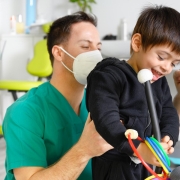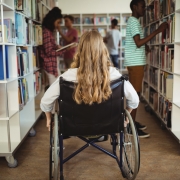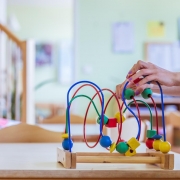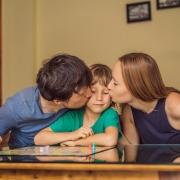Six Tips to Help Prevent Wandering and Wandering-Related Tragedies
From AWAARE: Autism Wandering Awareness Alerts Response Education Coalition
A research study confirmed what many parents know well: Wandering by children with autism is common, dangerous and puts tremendous stress on families. We also know that people with autism of all ages can have wandering tendencies. Review the resources and information below to help you develop a multifaceted safety plan which includes wandering prevention strategies.
1. Secure Your Home
Consider contacting a professional locksmith, security company or home improvement professional to promote safety and prevention in your home. You may find it is necessary to prevent your loved one from slipping away unnoticed by installing secure dead bolt locks that require keys on both sides, a home security alarm system, inexpensive battery-operated alarms on doors, placing hook and eye locks on all doors above your child’s reach, fencing your yard, adhering printable STOP SIGNS to doors, windows and other exits, etc.
2. Consider a Locating Device
Check with local law enforcement for Project Lifesaver or LoJak SafetyNet services. These tracking devices are worn on the wrist or ankle and locate the individual through radio frequency. Various GPS tracking systems are also available.
3. Consider an ID Bracelet
Medical ID bracelets will include your name, telephone number and other important information. They may also state that your child has autism and is non-verbal if applicable. If your child will not wear a bracelet or necklace, consider a temporary tattoo with your contact information.
4. Teach Your Child to Swim
Swimming lessons for children with special needs are available at many YMCA locations. The final lesson should be with clothes on. Remember: teaching your child how to swim does not mean your child is safe in water. If you own a pool, fence it and if neighbors have pools, let them know of these safety precautions and your child’s tendency to wander. Remove all toys or items of interest from the pool when not in use.
5. Alert Your Neighbors
It is recommended that caregivers plan a brief visit with neighbors to introduce their loved or provide a photograph. Knowing your neighbors can help reduce the risks associated with wandering. See the caregiver tool kit below for resources to use to alert them.
6. Alert First Responders
Providing first responders with key information before an incident occurs may improve response. Informational handouts should include all pertinent information and be copied and carried with caregivers at all times. Circulate the handout to family, neighbors, friends and co-workers, as well as first responders. See the tool kits below for resources to use to alert them.
Additional Tips and Strategies to Prevent Wandering:
- Six Tips to Help Prevent Wandering and Wandering-Related Tragedies
- Seven Steps to Prevent Wandering at Your Child’s School
- Wandering Prevention Tips from the Autism Speaks Community
- Wandering and Autism: Tips from a National Expert
Be Prepared with Emergency Information at your Fingertips:
Use these printable forms and handouts from our Autism Safety Kit to develop a multifaceted safety plan specific to a person with autism’s unique needs. Remember, a person with autism’s safety needs can change as they get older or when there is a sudden change in routine, so the safety plan should be updated on a regular basis.
It is important for the safety plan to cover all areas of the person with autism’s life including home, school, and any community activities. Inform all teachers, caregivers, and trusted community members about the safety plan. Many families share the forms with their local first responders.
Safety & Wandering Prevention Checklist
Family Wandering Emergency Plan
Seven Steps to Prevent Wandering at Your Child’s School
Wandering Tips for First Responders
AWAARE: The Autism Wandering Awareness Alerts Response and Education Coalition
The Autism Wandering Awareness Alerts Response and Education (AWAARE) Collaboration is a working group of six national non-profit autism organizations whose mission is to prevent autism-related wandering incidents and deaths. The AWAARE Collaboration works to prevent wandering incidents and wandering-related deaths within the autism community through the use of collective organizational resources, and by establishing and monitoring objectives, guidelines, policies, and tools that promote awareness, education, prevention and safety.
Click here to learn more about and for resources and tools from AWAARE.
Big Red Safety Tool Kit: A Digital Guide for Caregivers
The Big Red Safety Tool Kit from the National Autism Association is designed to provide direct aid and support to families of children with autism at risk.The kit contains the following resources:
- Caregiver Checklist Tool
- Family Wandering Emergency Plan
- Autism Elopement Alert Form: Person-Specific Information for First Responders
- Swimming Lessons Tool
- Root-Cause Scenarios and Strategies
- Stop Sign Prompts
- Social Stories
- Caregiver Log
- Sample Wandering Prevention IEP Letter
- Tracking Technology Information (Steps to Take, About, Types)
- General Awareness Letter
- Five Affordable Safety Tools
- Resources One-sheeter
A Digital Resource for First Responders
The Big Red Safety Tool Kit for First Responders from the National Autism Association is designed to help first responders understand autism and become better equiped to respond in an emergency situation involving an individual on the spectrum.
The kit contains the following resources:
- Autism Overview/Autism Behaviors
- Autism and Wandering Information
- First Responder Checklist
- First Responder Tips
- First Responder Notification Form
- Guidelines for Missing Persons with Special Needs (NCMEC)









